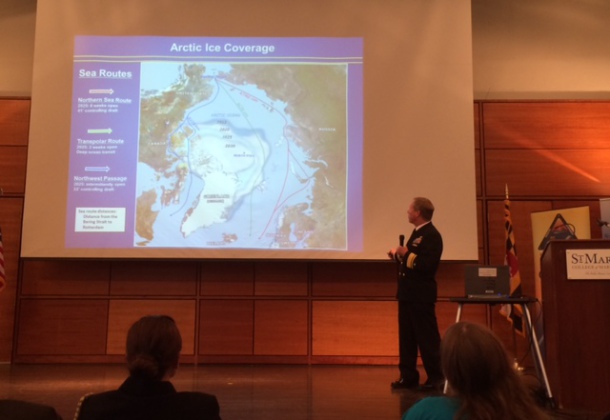Navy Connects Climate Change to Conflict

Climate change and geopolitical instability are linked, adding an urgent element to defense, diplomatic and environmental policy-making, said the oceanographer and navigator of the U.S. Navy in a lecture sponsored by The Patuxent Partnership and the Center for the Study of Democracy at St. Mary’s College of Maryland.
RADM Jonathan White, who is also the Navy’s director of Space and Maritime Domain Awareness, addressed three key areas that have the Navy working intensively to protect maritime safety and effectiveness: changes in the Arctic, coastal infrastructure, and global security.
“All climate change as it impacts people is about water,” RADM White said. There’s a correlation between the amount of carbon dioxide in the atmosphere and temperature change. CO2 levels have been rising since 1958, spiking in May,” he said. “The last time it was at that level there was no human life on earth.”
Because “the Navy needs to operate on any ocean at any time,” RADM White said, conditions in the Arctic Ocean have become a concern. The breaking up of multi-year ice caused by warmer temperatures is making the Arctic more accessible but also more dangerous. “It’s a game-changer for submarines” accustomed to passing under ice that is now breaking up and moving.
As a result, United States involvement in the Arctic is getting extra attention. The Navy developed a 2014-2030 roadmap for the Arctic. And in 2015-2017, the United States will take its turn chairing the Arctic Council, a group of nations whose territories touch the Arctic Ocean. The U.S. emphasis will be on the impact of climate change, stewardship of the Arctic, and improving the economic and living conditions of those who depend on the ocean, RADM White said.
Turning to coastal infrastructure along the heavily developed Eastern Seaboard, RADM White said the Navy is assessing the vulnerability of Navy properties at Pax River, Norfolk and Annapolis, as well as conducting a worldwide analysis of potential flooding of Navy installations. Of these, Norfolk presents the biggest problem, RADM White said. In the mid-Atlantic, as sea levels are rising, at the same time land is subsiding, creating a double threat to homes, businesses, and military resources. An initiative is under way in greater Norfolk to bring public and private interests together to attack a problem daunting because of the sheer scale of the assets involved.
Asked by an audience member if there would be a “tipping point” in the mid-Atlantic because of rising sea levels, and if we would be around to see it, RADM White said, “We are not going to see it. We could see a tipping point in the Arctic if the big chunk of ice in the middle of the ocean starts to break up. But I don’t have a good gut feeling on when that would be.”
Internationally, RADM White said, “Some places with the highest population centers are the most vulnerable.” He cited Bangladesh where agricultural lands are being ruined as river water is diverted above them for other uses, and where sea water from the south is pushing inland, sometimes bringing sewage with it. In Bangladesh, up to 30 million people could be displaced. Neighboring countries don’t welcome migration from people fleeing the crisis. It’s a clear example, among many, he said, of how climate change creates conditions that cause economic and political upheaval.
Another impact of climate change is not too much water but not enough, reminding listeners that drought was a catalyst for the conditions leading to the Syrian conflict.
Solutions to a problem this complex are never easy, and “impossible to do with a sequestration budget,” RADM White said. “In Bangladesh, do you send in SeaBees or MDs?”
Finding funds to address global security and conflict issues related to climate change remains problematic, not least because of the politics around climate change. RADM White says the Navy’s approach is partnering with academics, entrepreneurs and other agencies that share interests in finding solutions. One goal, he said, is to reduce dependence on oil, gas and coal supplies from parts of the world that could become unstable.
























This is very encouraging. It’s way past time that human induced climate change is recognized. We in Southern Md are already impacted by rising tides. St. George’s Island is frequently flooded and as other parts of the Chesapeake, as is observed in Norfolk and islands disappearing, it is a present day not a future, problem. The reduction in the use of fossil fuels IS key. The EU is already for over a decade signed on to the “Third Industrial Revolution” a brainchild of Jeremy Rifkin. Energy in Europe is lateral and individually generated and connected to a grid that sends it where it is needed (IBM). It is not distributed from a centrally generated system, which is what the US seems to be hung up on. Regions of the US and particularly the mid Atlantic and the New England and Southern Canadian provinces do not want energy from the SW US. They prefer to keep their energy generation local. New England in particular, has more emphasis on locally and individually produced energy. It would be wonderful to see our local community of Pax River do the same. While great swaths of 10,000,000 gallons of oil has been discovered this past month on the floor of the Gulf of Mexico left by the great BP disaster, the US continues to issue more permits for oil drilling in that region. It is simply nuts. We have to get off of the tit of oil and gas and move on. Europe is doing it. With the resources that the US Navy possesses it is encouraging they are taking a good look at how to remove its dependence on fossil fuels. The US military is the largest consumer of energy in the world, and BP is it’s biggest provider of those fuels. It is a human tragedy and a tragedy for the earth and all of its inhabitants.